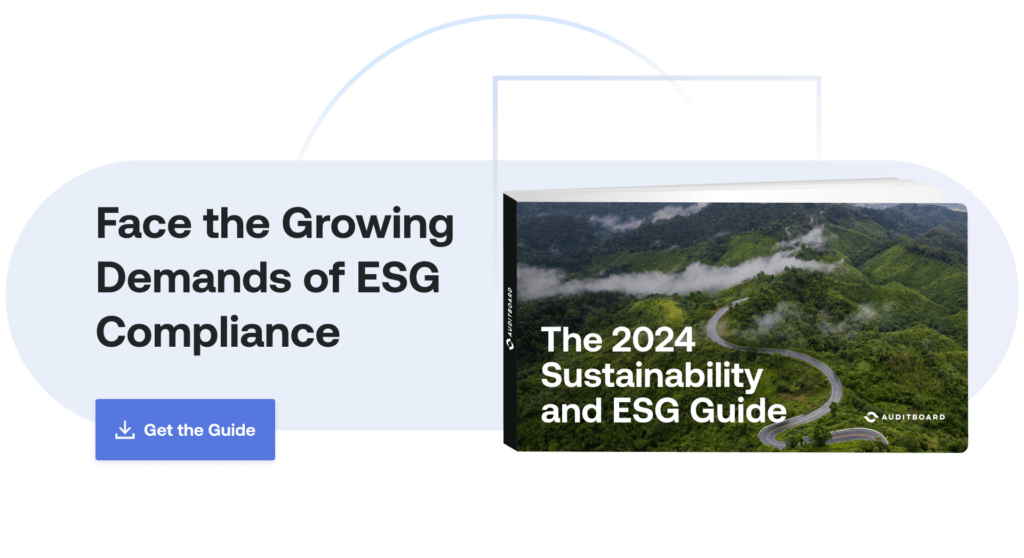
August 9, 2024 • 9 min read
ESG Data Management Checklist

Claire Feeney
The biggest hurdle posed by the new ESG reporting regulations is that companies’ disclosures must undergo assurance, meaning their reporting data will be subject to the same level of scrutiny as financial reporting. Of note for businesses in the U.S. and European Union, mandatory limited assurance is, or will be, required by:
- The European Union’s Corporate Sustainability Reporting Directive (CSRD)
- The SEC’s Proposed Climate Disclosure Rules
- California’s Climate Corporate Data Accountability Act (SB 253)
Companies impacted by these regulatory requirements can also expect they will eventually be required to provide reasonable assurance for their ESG data down the line.
Download the full Sustainability and ESG Guide for a deep dive into the subject and read on to learn:
- What your organization can expect in terms of assurance costs and upcoming climate disclosure deadlines
- How internal audit can lead the charge to leverage existing financial reporting structures to achieve similar transparency for climate reporting
- A checklist of key capabilities to seek in your ESG technology solution.
The Challenges of Avoiding Greenwashing
The best way to avoid greenwashing claims is by ensuring your business has access to quality, accurate, and verifiable ESG data. However, because ESG risk is owned by so many different stakeholders across the business — in addition to third-party vendors, customers, and partners — ensuring ESG data quality is challenging for many reasons including:
- Data Availability and Accessibility: ESG data is often not readily available and difficult to access across various departments and external sources.
- Data Quality and Consistency: Difficulty ensuring the accuracy, reliability, and consistency of ESG data.
- Resource and Capacity Constraints: ESG data collection can be resource-intensive. Organizations may face constraints in terms of the available budget, technology, and human resources dedicated to ESG data management.
- Standardization Issues: The lack of standardized metrics and the evolving nature of ESG reporting frameworks make it difficult to ensure that the data collected aligns with current standards and stakeholder expectations.
- Difficulty Integrating with Existing Systems: Integrating ESG data collection with existing IT and data management systems can be challenging, especially if those systems were not designed with ESG data in mind.
- Scope and Boundary Issues: Determining the scope of what ESG data to collect, especially when dealing with complex supply chains or operations spanning multiple jurisdictions, can be a complex task.
- Data Privacy and Security: Ensuring the privacy and security of ESG data, particularly when it involves sensitive information, is a growing concern.
To combat these data challenges, ESG teams can take a multifaceted approach toward standardizing the ways in which ESG data is collected, stored, and managed across the organization and with its external partners.
ESG Data Management Checklist
Ensure there are adequate quality control guardrails on your ESG data with the following considerations for data collection and stakeholder involvement.
Data Collection Considerations
- Integrated Data Management System
Prioritize a centralized ESG data management system that allows for easy input, storage, and retrieval of data. - Prioritize a centralized ESG data management system that allows for easy input, storage, and retrieval of data.
- Automated Data Collection Tools
Implement automated tools for data collection wherever possible. - Implement automated tools for data collection wherever possible.
- Clear and Consistent Frameworks
Establish clear frameworks and guidelines for what data needs to be collected. - Establish clear frameworks and guidelines for what data needs to be collected.
- Purpose-Built Tools for Carbon Accounting
Implement specialized software and tools designed specifically for carbon accounting. - Implement specialized software and tools designed specifically for carbon accounting.
- Quality Control Measures
Implement quality control measures to ensure data accuracy and reliability. This helps in reducing the need for repeated data collection due to errors. - Implement quality control measures to ensure data accuracy and reliability. This helps in reducing the need for repeated data collection due to errors.

Stakeholder Considerations
- Training and Awareness Programs
Educate process owners and employees about the importance of ESG data, how it’s used, and the benefits it brings.
Provide training on how to use data collection tools and systems effectively. - Educate process owners and employees about the importance of ESG data, how it’s used, and the benefits it brings.
- Provide training on how to use data collection tools and systems effectively.
- Regular but Reasonable Reporting Schedules
Set a reporting schedule that balances the need for timely data with the workload of process owners.
Align data collection with existing business processes or reporting cycles when possible. - Set a reporting schedule that balances the need for timely data with the workload of process owners.
- Align data collection with existing business processes or reporting cycles when possible.
- Consolidate Your Process Owner Asks
Standardize similar metrics across different frameworks and units to ensure consistency and ease of aggregation.
Ensure you are only asking process owners this information once. - Standardize similar metrics across different frameworks and units to ensure consistency and ease of aggregation.
- Ensure you are only asking process owners this information once.
- Stakeholder Engagement and Communication
Solicit process owners’ feedback on the data collection process and implement improvements based on their suggestions.
Ensure that process owners understand their role in the larger ESG strategy, which can enhance their commitment to the process.
Keep lines of communication open with process owners. - Solicit process owners’ feedback on the data collection process and implement improvements based on their suggestions.
- Ensure that process owners understand their role in the larger ESG strategy, which can enhance their commitment to the process.
- Keep lines of communication open with process owners.

The future of more responsible sustainability and ESG reporting starts with informed and proactive steps today. For more insight on navigating the challenges of new and upcoming ESG disclosures, AuditBoard’s Sustainability and ESG Guide provides actionable solutions to ensure a resilient and effective ESG program. Seize the opportunity to stay ahead — download the full guide to uncover essential tips and best practices for shaping your ESG strategy.
About the authors

Claire Feeney is a Senior Product Marketing Manager at AuditBoard focused on ESG and RiskOversight. In her role, she helps support organizations in transforming their enterprise risk management and sustainability programs. Prior to joining AuditBoard, Claire worked in product marketing at OneTrust, VMware, and Infor. Connect with Claire on LinkedIn.
You may also like to read


NIST CSF 2.0: What IT compliance managers need to know

Building resilience with IAM: Unifying access, risk, and compliance

ISO 27001 risk assessment: A practical guide for IT compliance managers

NIST CSF 2.0: What IT compliance managers need to know

Building resilience with IAM: Unifying access, risk, and compliance
Discover why industry leaders choose AuditBoard
SCHEDULE A DEMO




